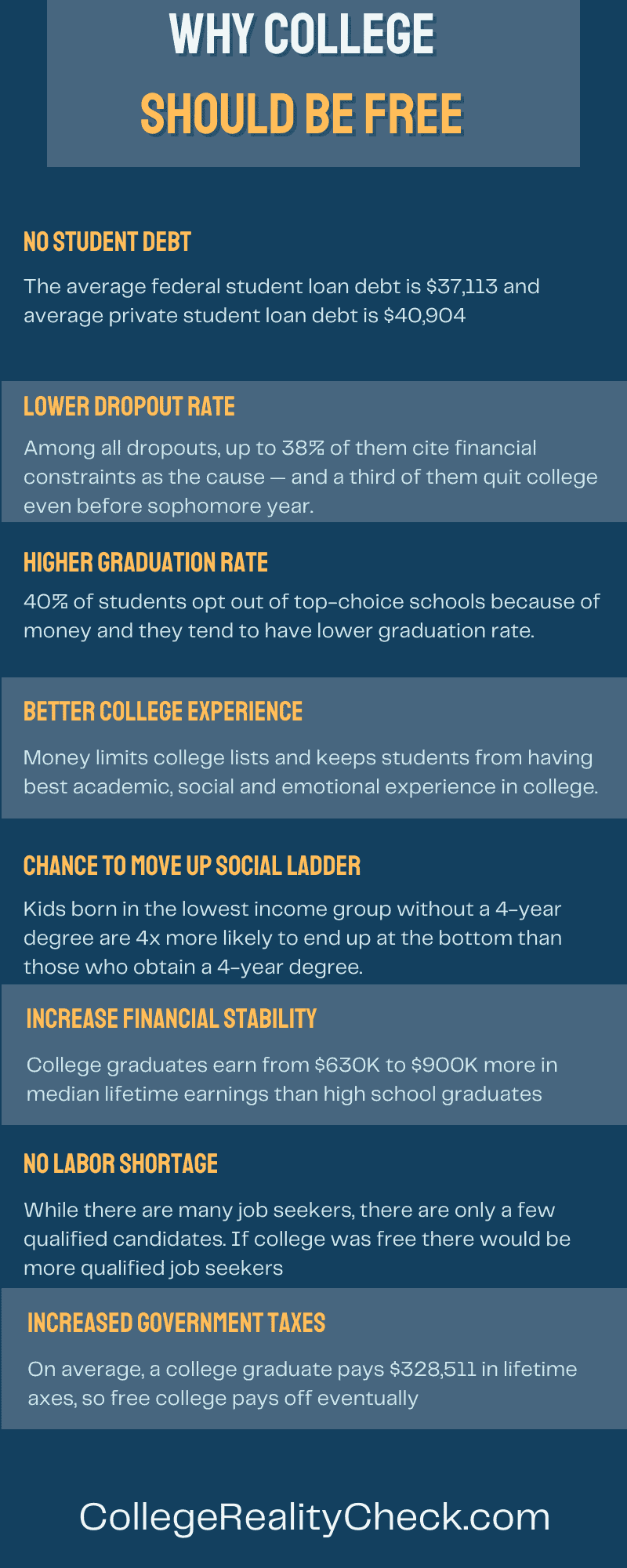10 Reasons Why College Should Not be Free and 12 Reasons Why It Should Be
Earning a college degree is synonymous with access to more job opportunities, increased earning potential and significantly higher lifetime earnings. However, going to college is also linked to exorbitant tuition costs, outrageous student debt and inaccessibility to many students from low-income backgrounds.
Many of the downsides that come with attending college can be resolved with one thing: making it free.
In this post, we will talk about some of the reasons why college should be offered free of charge as well as why it should not come for free. Since anything is possible, you will realize that some of the good things free college can bring can be negated by some of the bad things it can bring — so don’t stop reading now!
But before anything else, let’s answer this question a lot of low-income students are too shy to ask…

Does Free College Exist?
Free college is available for less than 1% of all students who get full-ride scholarships. The free college also exists in some states where there are tuition-free programs available for eligible students. As of this writing, there are around 20 states in the US that offer some type of free college.
There is one surefire way to earn a college degree cost-free: earning a full-ride scholarship.
A full-ride scholarship, simply put, covers all expenses that have something to do with college — from tuition, books to room and board. In many instances, the awardee’s living costs are covered, too.
Depending on which college or university grants it, a full-ride scholarship can sometimes amount to more than $200,000.
While it’s true that a full-ride scholarship can make earning a degree less problematic for someone who is from a low-income background, there is one problem: this type of aid can be extremely rare.
As mentioned above, less than 1% of students win full-ride scholarships per year — that’s equivalent to around 20,000 degree-seeking incoming freshmen students!
A free ride scholarship can either be need- or merit-based. Either way, one thing is true: available free-ride scholarships are very competitive. And the more selective the school that awards it, the harder it is to win a free-ride scholarship. You will have to have a certain GPA and demonstrate certain skills and competencies, among other requirements.
Besides getting your hands on a full-ride scholarship, you can also enjoy free college by attending an institution in one of the few states with tuition-free programs.
States where there are free college tuition programs for eligible students at four-year institutions include:
- Indiana – Program: 21st Century Scholarship
- New York – Program: Excelsior Scholarship
- Washington – Program: College Bound Scholarship Washington
In the following states, there are free college tuition programs for qualified community college students:
- California – Program: California College Promise Grant
- Delaware – Program: Delaware Student Excellence Equals Degree (SEED) Scholarship Program
- Hawaii – Program: Hawaii Promise Scholarship
- Maryland – Program: Maryland Community College Promise Scholarship
- Michigan – Program: Michigan Reconnect
- Missouri – Program: A+ Scholarship Program
- Montana – Program: Montana Promise Act
- Nevada – Program: Nevada Promise Scholarship
- New Jersey – Program: Community College Opportunity Grant
- New Mexico – Program: Opportunity Scholarship
- Oklahoma – Program: Oklahoma’s Promise
- Oregon – Program: Oregon Promise
- Rhode Island – Program: Rhode Island Promise Scholarship
- Tennessee – Program: Tennessee Promise
And then there are also states where there are free college tuition programs but are limited by certain factors:
- Arkansas – Program: Arkansas Future (ArFuture) Grant
- Kentucky – Program: Work Ready Kentucky Scholarship
- Kansas – Program: Kansas Promise Scholarship
- Virginia – Program: G3
- South Dakota – Program: Build Dakota
- West Virginia – Program: West Virginia Invests Grant Program
But just because you are going to a school in one of these states doesn’t mean right away you will enjoy a tuition-free college experience.
As expected, there are certain eligibility requirements to meet. Some of them include being a resident, having a particular high school GPA and attending a certain type of institution.
Now that the fact that free college — well, in many instances, to some extent — actually exists, it’s time to dive straight into the heart of this post: reasons why college should not be not free and why it should be free.
Let’s start on a positive note…

12 Reasons Why College Should be Free
Graduating high school students who do not intend on attending college have different reasons for going straight into the workforce immediately after obtaining their high school diplomas. One of them, without any doubt, is that college is too expensive. So, by making college cost-free, chances are that they will have a change of heart.
Wondering what earning a degree would be like if college isn’t as damaging to the pocket as it is today? Below, you will come across the different reasons why it being free of charge is a great idea.
No student debt
According to data from Statista, the average federal student loan debt per borrower amounts to $37,113. On the other hand, the average private student loan debt per borrower can be as high as $40,904.
While it can be extremely challenging to graduate from college without any student loan debt, especially among low-income students, it’s possible.
As a matter of fact, as much as 38% of undergraduate students graduate without any student loan debt — of those, more than half attended associate programs and less than a third attended bachelor’s programs.
By offering college at no cost, the percentage of graduates with zero student loan debt will increase.
Because of this, employed degree holders can use much of their earnings to gear up for the education of their kids or their retirement rather than to pay off student loans for the next 20 years of their professional lives — some of those with professional degrees can take up to 45 years to repay their student loans!
Increased college enrollment
If college were free, then no graduating high school students would have to consider the cost when building a college list or deciding whether or not they will go to college — everyone would probably apply straight to their dream schools.
Prestigious colleges and universities would become more popular.

On the other hand, public ones would get more funding from the state and federal governments.
And it’s not just degree-granting institutions that could benefit — businesses and organizations would also enjoy the fact that there would be plenty of qualified individuals to hire.
But keep in mind that even if earning a degree came free of charge, it might not necessarily entice everyone to apply to colleges and universities after high school.
Skepticism for the need for higher education, availability of jobs for people whose highest educational attainment is a high school diploma, making enough money at one’s current job, having successful parents who have no degrees, the absence of an idea of what to do with one’s life — these and more can keep a person from enrolling in college.
Lower dropout rate
There are many different reasons why students drop out of college. Among all dropouts, up to 38% of them cite financial constraints as the cause — and a third of them quit college even before their sophomore year.
If you are from a low-income family, dropping out would likely be the least of your worries if college were free.
But making college free won’t necessarily keep students in school. The steep cost of college is one of the reasons why some students drop out — it’s not the only reason.
Academic stress, uncertainty of one’s chosen major, conflict with personal or work commitments, and unhappiness with the overall college experience are some other common reasons.
Higher graduation rate
Colleges and universities with the highest graduation rates tend to be the most selective and expensive. Meanwhile, those that are less selective and expensive tend to have the lowest graduation rates.
One of the most common reasons behind a college’s low graduation rate is the dissatisfaction of the students with their experience there, which can be due to making the mistake of choosing a school that isn’t the perfect fit.
And why do many students fail to attend their dream colleges?
The short answer is money.
According to the study, 40% of those who opt out of their top-choice schools cite cost as the reason.
If college were free, then you would be able to attend the college of your preference no matter the cost of attendance, thus considerably increasing your chances of graduating — a good fit college is a school that can meet your academic needs as well as keep you from being burdened financially.
Better college experience
It’s not uncommon for students from low-income backgrounds to stick to public in-state colleges and universities in order to keep the cost of earning a degree as low as possible.
While there are many highly-ranked in-state schools, limiting yourself to an institution in your state, in some instances, means making do with the programs and resources that it offers, which can keep you from having the best possible college experience that supports your various academic, social and even emotional needs.
Without having to worry about steep out-of-state tuition costs as a result of free college, there is no need to feel guilty about overburdening your parents financially when adding schools in other states to your college list.
A positive college experience is vital in order to become a well-rounded student and a competitive job applicant.
More people with double majors
It is estimated that 25% of undergraduate students are double majors. However, some colleges and universities say that 30% to 40% of their attendees are doing double majors!
There are many perks that come with double majoring.
Some of them include acquiring more skill sets, having more career opportunities and enjoying higher starting and long-term salaries. However, there are also a few cons that come with committing to two majors. And more time and more money spent in college lead the list.
With free college, however, the financial hurdle posed by a double major goes out of the window.
If college were available to students at no cost, those who wish to double major would still have to spend more semesters in school alright, but they could quit worrying about the economic aspect of it.
And if they were attending institutions that allowed students to have up to three majors at once, they could give it a go without leaving the bank in shambles.

Increased job opportunities
If college were free, more individuals would be able to apply for jobs that otherwise they would be unqualified for.
This would be especially beneficial for poor students — after all, those with a college degree are more likely to be able to climb the economic ladder than those without.
According to the Pew Research Center, kids born in the lowest income group who do not earn a four-year degree are four times more likely to end up at the bottom than those who obtain a four-year degree.
Needless to say, free college would not only solve unemployment but also economic poverty.
The Department of Economic and Social Affairs (DESA) of the United Nations (UN) says that labor is often the only asset that the poor can use in order to improve their well-being. Therefore, allowing them to have the opportunity to earn a degree for free in order to qualify for available jobs can help in the attainment of poverty reduction.
Increased financial stability
Everyone knows that one of the benefits of a college degree is increased earning potential. This perk is evident from the get-go, says the 2021 Salary Survey report by the National Association of Colleges and Employers (NACE).
The average starting salary of degree holders shows an upward trend, based on data from the said report.
For the Class of 2020 graduates, for instance, the average starting salary was 2.5% higher than the average starting salary amounting to $53,889 for the Class of 2019 and up 8.5% from the Class of 2018’s average starting salary of $50,944.
But the perks of graduating from college salary-wise don’t begin and end with one’s initial job.
Numerous studies show that individuals with a college degree make significantly more money throughout their lifetime than those with a high school diploma only. Needless to say, it can be easy for them to attain financial stability, which is why they earn anywhere from $630,000 to $900,000 more in median lifetime earnings than high school graduates.
Resolved labor shortage
In 2021, over 47 million workers in the US quit their jobs. Their reasons for resigning were varied — some wanted better compensation, while others wanted a more balanced work-life ratio.
But it doesn’t mean employers can easily replace those millions of vacant job positions. While there are many job seekers, there are only a few qualified candidates.
This results in a labor shortage, which can be more complicated than it seems. During a labor shortage, it’s not just filling positions that become challenging but also retaining employees.
In order to counter this, employers may have to pay higher salaries and improve benefits.
If earning a college degree were costless, there would be a lot of qualified job seekers. Needless to say, a labor shortage could be a thing of the past. And it’s not just employees that would be happy for being able to work in fields related to their expertise but also employers for having successful businesses.
Increased government revenue (taxes)
It’s no secret that having a college degree is critical to having a high-paying job. Not all majors are created equal — some are higher-paying than the rest, such as those that allow degree holders to hold job positions in health care, engineering, information technology, finance and legal.
However, the higher the salary, the higher the income tax rate.
For the US government, the federal income tax is the largest source of revenue. As a matter of fact, in 2021, the US government collected revenue amounting to a whopping $4.05 trillion!
Cost-free college is perfect for students who can’t afford a degree today but are willing to contribute to government revenue after four to six years — on average, a college graduate pays $328,511 in lifetime taxes.
Fulfillment of right to education
According to Article 26 of the Universal Declaration of Human Rights, everyone has a right to education and it shall be directed to the full development of the human personality as well as to the strengthening of one’s respect for human rights and fundamental freedoms.
And since human rights are inherent to all human beings, no matter the race, ethnicity, language, religion, sex, age or any other status, they cannot be taken or given away.
It’s exactly because of this why the US government is funding public and state colleges.
Still, earning a degree from these institutions is, most of the time, only cheap and not entirely free. If college were free, more and more students would be able to practice their right to education, including especially low-income ones.
Better services to the citizens
As a college graduate with a high-paying job, it’s not just you and your loved ones that can benefit from your paycheck — the entire US population can benefit from it as well, believe it or not.

Money collected by the US government through federal taxes is used to shoulder the costs of the growth and upkeep of the nation. Some of the things that federal tax funds are used for include building and maintaining infrastructure as well as improving various sectors such as agriculture and public transportation.
Huge sums also go into the funding of Social Security programs, health programs such as Medicare and Medicaid, and pensions and benefits of government workers. Some go into the provision of emergency relief.
Being able to attend college for free allows you to obtain all the knowledge base and skill set you will need in order to land a job that pays well, contribute a larger amount of money to the US government revenue in the form of federal tax, and help provide your fellowmen with the services and benefits they need.
And now, let’s check out some of the negatives…
10 Reasons Why College Should Not be Free
The steep cost is the main reason why the majority of high school graduates who skip college would prefer to get a job than earn a degree. While having access to free college sounds like a fantastic idea, in the real world, however, there are some downsides that come with it, many of which can be quite serious and alarming.
Wondering what it would be like if college were free? Wonder no more — below are some of the things that are very much likely to happen if getting a college degree suddenly becomes free of charge.
Increased student-to-faculty ratio
There are many perks that come with attending a college with a low student-to-faculty ratio. Some of the most noteworthy ones include more individualized attention, increased social engagement within the classroom, and a better learning environment. So, in other words, it contributes to a more positive college experience.
Some colleges, such as MIT and CIT, have an incredibly low student-to-faculty ratio of 3:1 in some classes.
If college came for free, you could say goodbye to having the opportunity to experience round-table discussions — chances are that you would spend each and every class of yours in a lecture hall where it is assumed that all students learn at the same style and pace and that all teachers are able to address the academic needs of every student.
Underpopulated less prestigious colleges
Many dream of attending some of the most elite colleges and universities in the land. However, only a few actually take the necessary steps in order to make that dream come true.
One of the main reasons why many steer clear of top-notch schools is that they have steep tuition costs.
And this is why if earning a degree came cost-free, the majority of graduating high schoolers would flock to prestigious schools due to their newfound affordability, leaving less-elite ones looking like ghost towns. However, while the cost might no longer be a hurdle to overcome, the selectivity level could still intimidate some applicants.
Harder eligibility requirements
Because of the huge possibility that hoards of college-bound kids would apply to the Ivy Leagues and Ivy-like institutions if college were free, chances are that prestigious schools would end up being even more selective.
An acceptance rate of 1% might be commonplace in order to make sure that only the most deserving get admitted.
But this could also serve as an incentive for high schoolers to partake in worthwhile extracurriculars, take challenging AP classes and get high GPAs for considerably increased chances of getting an acceptance letter from competitive colleges and universities that have just amped up their admissions process.
Since money would no longer be a huge problem, many bright and talented students from low-income backgrounds might feel less apprehensive and anxious about applying to prestigious schools notorious for their high tuition rates.

Higher dropout rate
Many high school teens who dream big work hard to get high GPAs. And many college students work even harder to complete their respective programs because college is expensive — they don’t want the money that their parents or they themselves worked hard for to end up down the drain.
But if college were free, many students might lose track of the value of hard work toward a degree.
Going to college without having to pay for associated costs might make earning a degree less challenging and interesting, thus causing students to lose motivation and drop out of college — since it’s free and there’s nothing to lose but time, they could always go back to college whenever they regain the drive to become degree holders.
Lower graduation rate
The graduation rates of colleges and universities can be affected by many different factors. Some of them include family income, the age of the students, and race or ethnicity.
Failure of a school to meet the expectations of the students is another.
Besides an increase in the student-to-faculty ratio, as earlier discussed, free college could also lead to a scarcity of resources as a result of a surge in attendees, which could make the overall college experience bad.
Some students might switch colleges, which wouldn’t be a problem since college is available for free, while others might take a break from their studies.
And then there are also those that might completely quit trying to earn a degree in order to give getting a job a shot. No matter the case, free college could result in lower four- and six-year graduation rates.
Reduced value of a college degree
In the US, the percentage of individuals aged 25 years and older with at least a bachelor’s degree is 32.1%. If college came free of charge, the number of degree holders in the US would be significantly higher.
Suppose that everyone who went to college at no cost graduated and earned a degree. Then the world would be packed with adults equipped with the knowledge and skills they would need to get a job. However, companies would provide lower pay and fewer benefits since anyone who applied would be a perfect candidate.
An undergraduate degree, ultimately, might wind up being worth a little more than a high school diploma.
And as a result of this, everyone with a bachelor’s degree would have to strive to earn a graduate degree in order to stand out from the rest of the undergraduate degree-holding crowd.
Reduced job opportunities
It’s true that a college degree can open doors to many different career opportunities. However, if everyone had a degree because of free college, college graduates might cause mayhem in the job market.

Since all applicants would have a degree, which would equal the playing field, employers might end up using benchmarks other than having a college diploma for the selection of candidates to hire — it could be anything from GPAs, involvement in extracurricular activities to special abilities.
Overqualification for jobs
On the flip side, besides having fewer career opportunities, many degree holders would become overqualified for certain jobs, including especially those in fields not related to their majors.
There are many perks employers can enjoy for hiring overqualified candidates. Some of them include a broader talent pool, lower training costs, lower management requirements and faster return to full productivity.
What’s more, introducing overqualified talents can challenge employees to exceed current expectations.
However, there are some downsides, too.
For one, it’s the perfect recipe for a high turnover — overqualified individuals may get bored or frustrated and soon leave for a job they are better suited for. Other employees and the managers themselves may feel anxious for fear of being replaced. Hiring overqualified talents may also stretch the payroll budget.
So, in other words, free college could saturate the job market with overqualified individuals that no businesses or companies would like to welcome aboard for fear of the negatives associated with hiring them.
Depletion of government funds
According to the latest data, the amount of money the US government allots to the funding of public and state colleges is $189 billion. From 2017 to 2022, the annual increase in the total funding is 1.8%.
That’s how much money is needed to keep degree-granting public institutions up and running.
If the cost of earning a degree at these schools were zero, more students would apply and the government would have to allocate more money to them in order to accommodate all attendees. It’s also not unlikely for private donors to public colleges and universities to call it a day in order to avoid winding up bankrupt.
Termination of certain federal or state programs
If college were free and public and state colleges ended up jam-packed with degree-seeking students, the federal or state government might have to abort some existing or planned projects as more funding would have to be apportioned to public two or four-year institutions.
Some of the programs that could wind up on the chopping block might have a minor impact on only a certain demographic, while others might have a substantial impact on everyone across the board.
Either way, free college could prove to be a threat to the nation’s funds.
Just Before You Wish That College Were Free
Free college comes with so many different perks — from making a degree more accessible to low-income students, very little to no student debt to increased chances of financial stability.
Others can benefit, too, from the state government to the entire citizenry.
But then there are also things that can make college that’s cost-free a bad thing. For instance, it can make the overall college experience bad due to stuff such as increased student-to-faculty ratio and reduced worth of a college degree.
As one Insider article has put it, people just don’t value the things they obtain for free.
Whether you are pro or anti free college, there are free college programs available in some states for students who need them and meet eligibility requirements, too.
The good news is that students from low-income families need not wait for college to be entirely free before they decide to earn a degree.
That’s because there are numerous ways to make college affordable, and it usually starts by choosing the right institution to attend and filling out the FAFSA form and submitting it ASAP, too.
Disclaimer: The views and opinions expressed in this article are those of the authors and do not necessarily represent those of the College Reality Check.





